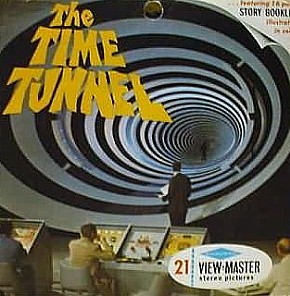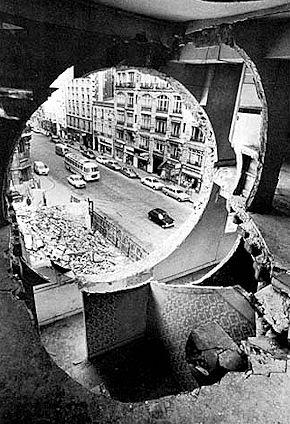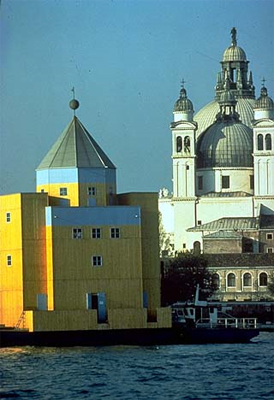2005.04.08 12:25
modernity/post-modernity
Does it say anywhere that modernism must end as soon as post-modernism begins?
If so, then who writes these rules?
Did Judaism end as soon as Christianity began? Did Christianity end as soon as Islam began?
2005.04.08 19:12
modernity/post-modernity
The religious analogy employed is not a stretch when you consider how this thread began, specifically in reference to a "paradigmatic shift". Christianity is a paradigmatic shift vis-à-vis Judaism, and Islam is (in part) a paradigmatic shift vis-à-vis Christianity.
Interestingly, the rise of Christian architecture did coincide with the end of 'classical' Pagan architecture--not long after Christian basilicas were built in Rome and Judea (under the supervision of St. Helena), the legislature under Constantine I (the son of St. Helena) began to steadily outlaw Pagan cults. Ultimately, under emperor Theodosius I, all Pagan cults within the Empire were outlawed, hence no more classical Temples.
Is what I do modern or is it post-modern? Honestly, I don't care.
Was it European Colonialism that began the end of many indigenous architectures throughout the "non-Western" world? Can the 'international style' of CIAM be seen somewhat as an extension of Colonialism?
These are questions that interest me much more than whether Gehry is modern or post-modern.
2005.04.11 13:23
modernity/post-modernity
What is the universal truth that Modernity believes in?
What are some examples of relative truths?
Isn't the notion that the world is "complex without objective truth" itself "a belief that there is some kind of objective universal truth?"
So Postmodernity replaces Modernity's certainty of rationality with the certainty of relativity?
Is "the ether" still the playground architectural theory plays in?
What is more truthful, professional architectural photography or the candid snapshot of a building?
2005.04.13 09:05
Architecture displaying movement?
And what exactly is time without the movement of matter through space?
2005.06.02 13:15
Kubrick, 2001 & 9-11
So the Lunar Monolith reenacts a Miesian slab and God as well?
I wonder how differently humanity would be thinking about architecture these days if the Great Pyramid was still like brand new. Blinded by the light, maybe?
| |
2005.10.12 17:46
Jimmy Venturi's new website...
...like, is it all conscious or sub-conscious, or osmotic even. I like it too because the 'artifacts', the designs, speak for themselves within a much larger architectural continuum.
...and seeing No. 9 again here made me think of the early Gehry three-in-a-row houses in Santa Monica(?), and then a lot of the "glass/wall boxy" houses designed now. And a couple of weeks ago the "pitched roof house" thread and seeing the Vanna Venturi House among the contemporary stuff also brought a perception to my eyes that wasn't there before.
I'll go for the continuum idea as to where architecture is really at.
2007.03.10 17:09
...and speaking of random tangents
"I think this room holds a portal to the fourth dimension."
I had very good reason for saying so, and the strangers I said it to agreed.

Today I'd call this show Random Tangents.
2008.12.03 00:44
where is the good new architecture?
Is there really all that much difference between 31 December 1999 and 1 January 2000? They're arbitrary place setters, and not the demarcation of disticnt different times. Metaphorically, the calendar is the cart, not the horse.
Personally, I see the Seattle Library design going back to Kahn's [and Tyng's] mid-1950s Municipal Building designs for Philadelphia. Historical analysis within a space-time continuum is more ongoing productivity and less end-product.
| |
2008.12.03 01:50
where is the good new architecture?
I'm sorry, but I just don't see arbitrary calendar dates and market value events as some kind of cause-and-effect ways to analyze, evaluate or categorize the evolution of architectural design. You mention the connection of Eisenman to CCTV, and I find that more relevant then whether CCTV is on a/your list of top 5 21st century buildings so far. And look at Le Corbusier's St. Pierre at Firminy-Vert, designed 1962, finally built a few years ago. Also Hedjuk's Bye House.
I prefer to watch architecture history as it actually unfolds, and not through the aperture of somewhat artificial markers.
2008.12.03 08:00
pragmatists turning political?
I listened to most of the lecture while doing other work. Interesting, and likely even fruitful, typological analysis in terms of forms and how they may relate to programs and usage, but there remains the hint of force-fit and an even horizontal shift from 'iconic' analysis/design to 'political' analysis/design. As to this work's place within the continuum, I like how this is now being reenacted.
2009.01.29
Lost's ending
I now suspect, after seeing the third episode of Lost season 5 last night, that Lost will end with all of its original cast alive and together. This is how I see the current time traveling coming to a conclusion. It will be like Finnegans Wake and like Il Campo Marzio. Too bad Bloomer didn't make this vital connection.
So now it's exploration of the possibilities of the space-time continuum. Like Proust was a neuroscientist, was Piranesi, with the Ichnographia Campus Martius, a scientist of the fourth dimension? (Here is where I have to review Dixon's "Ichnographia as Uchronia".) Is Ichnographia Quondam also a study/experiment of architecture (and urbanism) in the fourth dimension? For IQ the time continuum connection is the Axis of Life/Benjamin Franklin Parkway connection, which comes after Piranesi's own Porticus Neronianae/St. Peter's connection.
Are the recombinant, appositional buildings of Quondam studies / experiments of architecture in the space/time continuum? Is that what they always have been? (Here is perhaps where I reread Geometry, Relativity and the Fourth Dimension.)
And what of The Odds of Ottopia? Did it all have a sense that even I did not fully understand? Bilocation was a significant part of the story. A step beyond Theatrics Times Two? What is Bilocation2 or Bilocation3, etc.--the studies of further powers within 2 = odd.
Quondam and Museumpeace as bilocation theaters? [tangental thought of Lost ending post at archinect written cryptically, with hints galore and lots of potential link at Quondam and Museumpeace] And all my posting activity over the last 12 years as writing / existing within the continuum as opposed to just within reality itself. Just looking now at the Virtual Domain collages I again see an architecture within the space-time continuum--the theme is widely present throughout my work, and I can now see on what foundation my further work rests. IS Quondam (and Museumpeace getting there) impenetrable becaue of its space-time existence? its slippages in and out of various time frames? (Do I write a comment at things.net?)
This is a great note because a breakthrough into understanding my (design) work is abundantly more clear. There is much here for me to elaborate on further, and I could formorly write about what Quondam is all about and indeed explain my work as a further approach to architecture. Does this also expalin my further approach to art?
And now, before I go to read Dixon's text (Uchronia), I'll end by mentioning that I now have to think about the relationship of reenactionary architecturism to traveling in the space-time continuum.
4704
4707
| |
2009.01.31 16:38
Re: Misc. stuff
After seeing Lost this past week I was inspired with a new way to think about Quondam and what I've sort of being doing there already--experiment with architecture within a/the space time continuum. For example, where some building models have already been collaged together, it's not just being playful but also seeing what it's like when architectures from different places and/or different times cross paths. Another example is how the Axis of Life of the Ichnographia matches the Benjamin Franklin Parkway is like where two different space/time architectures actually lock together (hence the Ichnographia Quondam). Anyway, I'm just starting to work on this stuff now, so not much more to mention. I'm just today in the final stretch of nicely redrawing a plan of the Palace of Versailles, and I'm looking forward to seeing how and where that will fit in within Quondam's space time continuum--remember, here a Versailles, there a Versailles, everywhere a Versailles, sigh!
2009.02.01 10:37
Venturi's Lieb (No. 9) House to be moved (or demolished)
Gordon loves it even more like that.

As does Aldo.

architectures in the space-time continuum
| |
2009.02.02 14:37
Venturi's Lieb (No. 9) House to be moved (or demolished)
I'd say that the Lieb House is now a museum peice. That's how the building's context has now changed. Villa Savoye hasn't moved, but its context has changed as well. It hasn't been a residence in many years, and it too is now a museum peice.
It was asked above what's going on at Guild House. According to "on the boards" of the VSBA website, Guild House is undergoing rehabilitaion. Just in passing, the physical context of Guild House changed drastically within the first decade of the building's existence. Spring Garden Street was much different/dense in the 1960s and bad zoning decisions changed the street into low-rise warehouses. It's kind of difficult to appreciate Guild House 'in context' now.
For what it's worth, I'm becoming much more interested in architectures within the context of the space-time continuum.
2009.02.09 09:14
Re: Reenacting paintings
Finally read the article, and yes it would have been more complete if the notion of reenactment was also addressed, as reenactment involves all the issues: reproduction, cloning, authenticity, degrees of separation, even, to some extent, space-time. I'd say the degrees of separation issue is here the most important in that, like you mention, the reproductions come extremely close to the original, and can even occupy the space of the original, but the reproductions can never be the original. I'm reminded of that aspect of calculus where the curve continues to more and more closely approach + or - 1 but never reaches the actual integer itself.
"Bifuracted authenticity" is an interesting notion, but, in terms of authenticity, it's a little misleading--there is still really only one authentic work (the reproduction Marriage of Cana even in original context is still a reproduction). Nonetheless, it brings to mind notions of the Baroque--"Within his double theater Bernini capsulized the beginning of Western culture's new bifurcation of the real and the illusory, introduced mirroring as a henceforth dominant (post) Baroque (stylistic) theme, and, at base (or should I say at the ultimate end), inverted reality into a reenactment of its own illusory mirror (--is this perhaps also the genesis of historiography?)." Plus, the mystical notion of bilocation, or is it actually something scientific as in the space-time continuum? Is the match of the Campo Marzio Axis of Life and the Benjamin Franklin Parkway an example of "bifurcated authenticity"?
So, generally, my take on the article is that 'reenactment' is missing and really should have been included. Greenaway essentially performed two reenactments--one the reenacted natural lighting in situ, and two the reenacted lighting on the reenacted painting at another/nearby site--and Factum Arte reenacted the Marriage of Cana at its original site.
Here a Versailles, There a Versailles, Everywhere a Versailles, sigh--going Baroque in the space-time continuum!
2009.02.17 07:58
Bilocation Syndrome
a purposeful walk
during the thick of reenactment season
through a space-time continuum
|